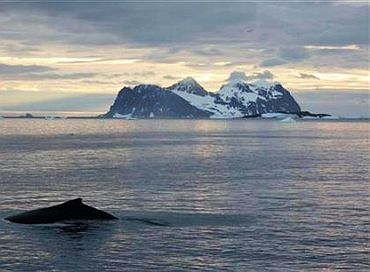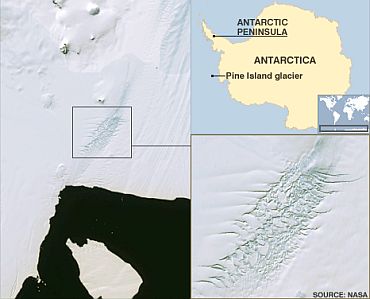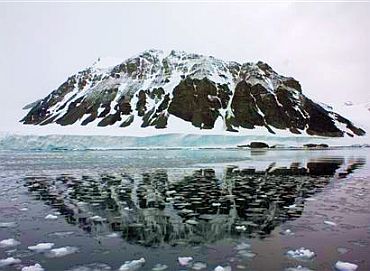Photographs: Alister Doyle/Reuters
Using Autosub, an autonomous underwater vehicle, an international team, led by the British Antarctic Survey, has captured ocean and sea floor measurements, which revealed a 300 metre high ridge on the sea floor.
Pine Island Glacier was once grounded on (sitting on top of) this underwater ridge, which slowed its flow into the sea. However in recent decades it has thinned and disconnected from the ridge, allowing the glacier to move ice more rapidly from the land into the sea.
An outcome of climate change?
Image: A NASA DC-8 makes a turn over Pine Island Bay as it heads back up the glacier for another mapping runPhotographs: Jane Peterson/NSERC/NASA
The warm water, trapped under the ice, is causing the bottom of the ice shelf to melt, thus resulting in continuous thinning and acceleration of glacier.
Lead author Dr Adrian Jenkins said: 'The discovery of the ridge has raised new questions about whether the current loss of ice from Pine Island Glacier is caused by recent climate change or is a continuation of a longer-term process that began when the glacier disconnected from the ridge.'
Why the finding is important
Image: The highlighted area shows a dense concentration of crevasses along one edge of the glacier. Large numbers of deep crevasses are a sign that parts of the glacier are moving rapidly.Photographs: NASA
'We do not know what kick-started the initial retreat from the ridge, but we do know that it started some time prior to 1970,' Dr Adrian Jenkins said.
'We now need to use other techniques such as ice core analysis and computer modelling to look much further into the glacier's history in order to understand if what we see now is part of a long term trend of ice sheet contraction. This work is vital for evaluating the risk of potential widespread collapse of West Antarctic glaciers,' he added.
A 'weak underbelly'
Image: The Sheldon glacier has retreated 2 km (1.2 miles) in 20 years and is nudging up world sea levelsPhotographs: NASA
Co-author Stan Jacobs added: "Since our first measurements in the Amundsen Sea, estimates of Antarctica's recent contributions to sea level rise have changed from near-zero to significant and increasing.
'Now finding that the PIG's grounding line has recently retreated more than 30 km from a shallow ridge into deeper water, where it is pursued by a warming ocean, only adds to our concern that this region is indeed the 'weak underbelly' of the West Antarctic Ice Sheet.'
'Increased melting of continental ice also appears to be the primary cause of persistent ocean freshening and other impacts, both locally and downstream in the Ross Sea.'
The findings have been published in the Nature Geoscience journal.





article